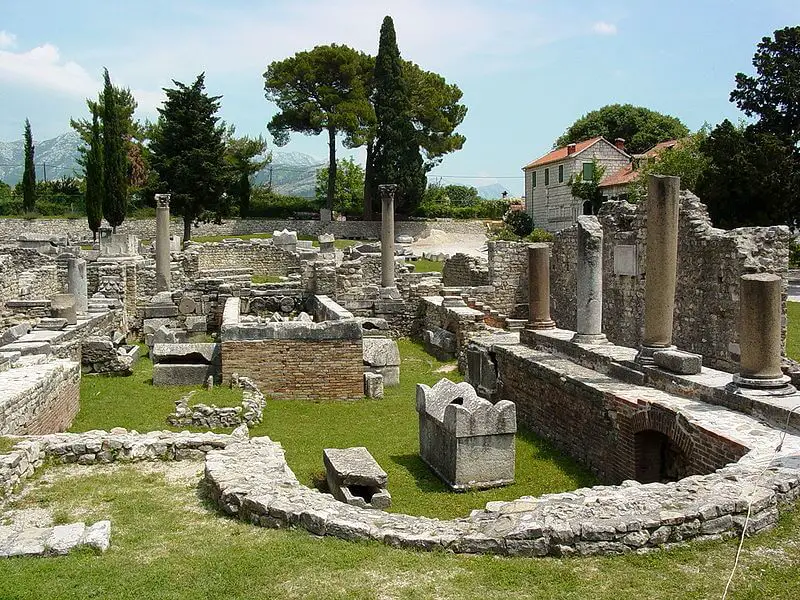Explore Old Town Split and Marjan Hill, Croatia
This walking tour is one of the best attractions in Split Old Town and nearby Marjan Hill. The self-guided walking tour can easily take you all day if you want to spend the afternoon at one of the two beaches in Split: Bene Beach or Kasjuni Beach.
- Additional self guided walking tours include:
- Walking tour and guide to Diocletian’s Palace
- Explore Beaches and Markets
- Roman Ruins – Town of Solin (Ancient Salona and home of Emperor Diocletian)
- Take the Ferry from Split to Hvar, explore Hvar Old Town, rent boat and explore the Islands and Secluded beaches around Hvar or rent a scooter and visit the Wineries, Fishing Villages and Lavender fields in Hvar
- Additional information and orientation of Hvar Island
Download interactive Map HERE

Old Town Split and Marjan Hill Walking Map, Click to Download PDF HERE
Walking Tour Stops
1. Riva
Sea Promenade. The place where locals come to relax, see and be see.
2. Fruit Square, Voćni Trg
Located at the eastern side of Diocletian’s palace and in front of the Silver Gate, it is very picturesque. Officially the square is called Radic Brothers’ Square and has been named the most beautiful square in Split. It was the gathering place where villagers from the surrounding area came to sell their fruits and vegetables. You can still buy locally produced fresh fruit and vegetables here. The fresh food market opens very early and closes at 2pm.
Fruit Square is a fun lively place, where you can relax with coffee or traditional food at one of the open air market stalls or cafes. You enjoy the street music, the historic buildings that surround you and perhaps buy a souvenir to remember the day. It is easy to spend hours here, eating, shopping and bargaining!
In the centre of the square, the statue of the “Father of Croatian Literature” Marko Marulic has been erected. Today Fruit Square is the site of local fairs, vendors, stores, and restaurants visited by both locals and tourists. At night the subtle lighting creates and intimate atmosphere. There are several attractions.
In Fruit Square you may want to visit:
- Venetian Tower – the castle and tower was built in 1420 as part of the fortification of the square during the Venetian rule which ended in 1797. The building served as a watch tower in the protection of the area.
- Monument of Marko Marulic, a Croatian poet (1450-1524), he is the “Father of Croatian Literature”. Unsurprisingly it was made by the sculptor Ivan Meštrović and shows Marulic holding a book and reciting a verse by the Poet Tin Ujevic. If you travel through Croatia you will see monuments to Marulic and sculptures by Ivan Mestrovic in most of the major towns and cites.
- Events – Fruit Square is the location of various street performances by musicians and other performers. It also has vendors who sell souvenirs and handicrafts, maybe a cravat, made by locals. If you want something unique, try the scientific bookstore where you can buy interesting publications.
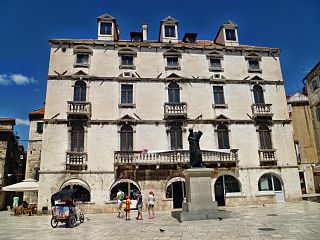
Milesi Palace – Named after a noble Italian family that made their home in Split for centuries. Their triangular palace is built in the renaissance-baroque style and is one of the most beautiful in Split. The palace is used for lectures and other scientific or cultural events
3. Old Town Hall, Stara Gradska
The old town hall is located on the north side of peoples square, and was constructed in the 15th century. Before it was destroyed in 1825, it also included the Rectors palace, the theater and the city jail. The building underwent restoration and reconstruction in 1890 and was rebuilt in neo-Gothic style. It was the administrative and ceremonial location for the City of Split. Today it is an enthnographic museum displaying temporary works of art and a has permanent display of how the people lived over the centuries. (Enthnographic: relating to the scientific description of peoples and culture with their customs, habits and mutual differences).
4. Peoples Square or Pjaca, Narodni Trg
A lively square that is part of the old town of Split, it was the first inhabited area outside of Diocletian’s Palace. It’s been the main meeting spot since the 14th century, replacing the peristyle in the palace which was the main gathering place then. The area is an example of harmony between the various architectural styles. It is easy to appreciate the beauty of the buildings painted in white, yellow or pink.
The square was home to two nobel families, the Karepić and the Cindro family
- The palace of the Nobel Karepić family with is distinct architectural details including in their coat of arms is located here. We will refer back to the family during the tour of Marjan hill as they were instrumental in building the monks residence on the hill named the Karepića kula
- The Cindro palace is built in the baroque architecture style with its majestic balconies and stone walls. In the 1800’s it became the residence of Marshall Marmoset who served under Napoleon.
The square also houses the old town hall and the clock tower. The clock tower was built by the Romans and is unique due its 24 digits instead of the standard 12 digits. Here you will find one of the oldest bookshops in Europe, Morpurgo and it looks almost the same as it was opened in 1860 as it has retained its character. It was the gathering place of many of Croatians literary figures and is still a very popular bookstore.
Live cam of Peoples Square
5. Republick Square, Trg Republike
Resembling St Marks Square in Venice, it is a large open square built in the Venetian style resembling a Venetian Piazza. It is surrounded by walls on three sides with an opening to the seaside with a breathtaking view of the Adriatic. Initiated in the 19th Century by the Mayor of Split, Antonio Bajamonti and built under the supervision of General Marmaontova, and it was designed by the Venetian project architect, Prokurative. He designed it in truly Venetian style as he missed his home in the city of Venice. Between the Square and the sea is a 19th century fountain by the famous Italian sculptor Luigi Ceccona. It had a practical function, and was designed to bring running water into the city. The sculptures have since been destroyed and the fountain looks a little out of place among the beautiful architecture of the surrounding area. Generally deserted in the winter time, Republic Square becomes lively as soon as the sun shines. The café chairs are quickly occupied.
6. Marjan Hill Stairs and Marjan Hill
Walk west towards Marjan Hill to one of its popular access points, Marjan Hill Stairs.
Marjan Hill is a large natural protected park ideal for walks, bike rides and rock climbing. Marjan is 178m tall and offers a view of the entire city from its viewing platform at the top of the stairs. It is a great break from the bustle of Split city center. There is a café near the view point for a well deserved snack. Marjan functioned as spiritual haven for the Split population and was regarded as a holy hill and a pilgrimage site. Because of this there are a number of churches on the hill. The viewing platform offers a view to the three churches on its slopes: St. Nicholas, St. Jeronimus and the Church of the Madonna of Bethlehem. From this view point you have a options of at least two walking routes:
Route one – in orange on the map
Walk along the northern flank for about 3km and on to Bene Beach (route in orange on the map). It is a great walk with wonderful views. Bene gets its name from the Church of St. Benedict located next to the beach. Once at Bene Beach, you should spend a few hours, and go to the café at the beach for a well-deserved snack. Bene beach is a rocky, pebble beach and is one of the oldest beaches in Split. It is a great beach if you are looking for something not “touristy”. Take the bus #12 back to the Riva when you are ready. You will get off at Autobusno stajalište Sv. Frane and walk to the Riva. There is a “tourist” tram that also passes through the area and takes you to Riva.
7. The Church of St. Benedict, Crkva sv. Benedikta
Bene beach and cove owe its name to the Church of St. Benedict, shortened to bene. The remains of the churches originate in the 11th or 12th centuries and the last date that it was mentioned in the history of the Church was 1362. Conservation took place in 2002 and in 2004 when the walls were partially restored to 50cm. Not much else remains of the church.
Route two – in purple on the map
Walk along the interior park for about 4km and onto to Kasjuni Beach (route in purple on the map). It is another great walk with several churches along the way. Once at Kasjuni Beach, spend a few hours there. Take the bus #12 back to the Riva when you are ready. You will get off at Autobusno stajalište Sv. Frane and walk to the Riva.
Attractions on Route two (purple route on map):
8. The Church of St. Nicholas, Crkva sv. Nikole
It is about 200 meters from the café and just where the gravel path starts. The Church of St. Nicholas is the first church along the route to Kasjuni Beach. Built by Elisabeth and Rako of Split in the year 1219, it was donated to St, Stephen abbey where the Benedictine monks, who later became hermits, took care of the Church. Nicholas was the protectors of the sea which is fitting as there is a great view of the sea from the Church. The church has undergone several repairs in 1919, 1950 and most recently by the Marjan Society in 1990 to its current state. On Dec 6, the feast of St. Nicholas a traditional mass is organized in the oldest Marjan Church. There is a place to refill water bottles next to the church
From St. Nicholas church, head west on the gravel road, past the small garden plot. There will be benches and wonderful scenery along the way. You will eventually come upon Our Lady of Bethlehem Church
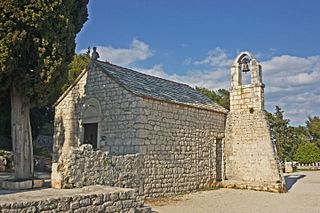
9. Our Lady of Bethlehem, Gospe od Betlema

A very simple church, with a single-nave, it was built in the 14th century with a carved nativity scene that has recently been restored. The nativity scene depicts Christs birth with St Jerome on one side and St Anthony, the hermit, on the other side. A picture of Christ’s crucifiction is above the nativity scene. It was used as a barn after World War 1 and reconstructed by the Marjan Association in 1927. This Church is the sight of holy mass held in the afternoon on Christmas Eve
10. Our Lady of Seven Sorrows, Gospa od Sedam Žalosti
This is another well preserved Church dated to 1362 AD. It is hidden under the branches of the pine trees. It is meant to give comfort to the less fortunate. You will note requests and wishes addressed to Our Lady, identified as Santa Maria Pietatis. The interior is thought to have a sculptured image of Pietatis Beatae Virginis relief made by famous artist, Juraj Dalmatinac. It is interesting to note that all Marjan churches have a west facing entrance, except this one
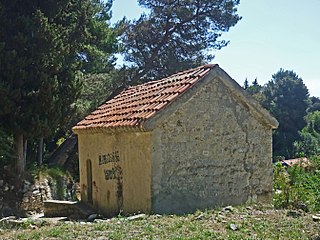
11. Church of St Jerome, Holy Jere
The Chapel of St. Jerome (St Jeronimus – Jere) was built in the 15th century. He was the patron saint of Dalmatia. It is thought that he lived in the cave and wrote his works in the cave. You will see a quote from St. Jerome with the inscription “MIHI OPPIDUM CARCER, SOLITUDO PARADISUS EST” translated as follows: THE TOWN TO ME IS A PRISON, AND SOLITUDE PARADISE.
The alter was built and signed by Andrija Alessi. You can see his signature as well as a sculpted image carved into the wall dated 1480, above the alter. The sculpture is that of St. John the Baptist, St. Anthony and St. Jerome.
Keep walking along the path and very close by to the church you will come across the cave ie: monastery built onto the wall. The monks who lived in the wall cave looked after the Chapels on the hill. They lived in poverty and relied on charity for food and the citizens of Split gladly obliged.
12. Karepić’s Tower, Karepića kula
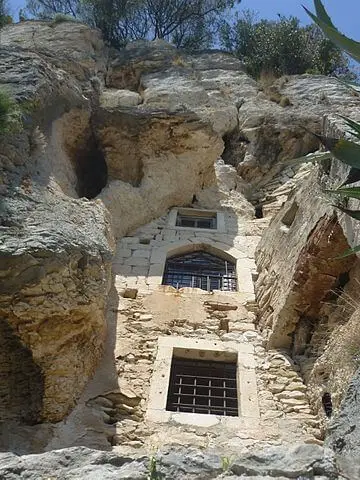
This is a narrow cave built into the cliff side that became the residence of monks. It is possible to get to the entrance by climbing uphill on a steep path, or by walking on a paved road from two directions. It’s a popular spot for rock climbing. The cave is located close to St. Jere (Chapel of St. Jerome). According to the coat of arms above the entrance, the cave area was built by the Karepić family in 1523. This same coat of arms is displayed at the Karepić palace in Peoples square in Split. The palace was built in 1564
13. Church of St. George
This is located at sea level on the western tip of Marjan Hill between Bene Beach and Kasunji Beach. You will see it if you take the Bus 12 back from bene beach.
The church was built around the 9th century and opens up to the Bay. The first level is about 20m above sea level. The church is rectangular with a semicircular apse, making it a unique feature. The Ottomans burned it down in the 17th century; however it has recently been restored.
Croatia Travel Destinations and Guides
- Dubrovnik
- Dubrovnik Game of Thrones and Old Town Self Guided Tour – Follow the Map and Guide to visit the film locations for Game of Thrones, beaches and churches. The self guided tour will take you a full day if you also visit the beaches. Use the map and attractions guide to visit the attractions of Old Town Dubrovnik and the locations of the Games of Thrones Scenes. The map has picture of the sites and how they looked for the film scenes. The walking tour will take you ½ a day. If you visit Lokrum island and spend time at the beach/monastery/fort on the island, this will take you another ½ day to full day. Lokrum Island is the location of the City of Qarth in GoT and is a 10 min water taxi ride from the Dubrovnik Port
- Dubrovnik Day Trips. Spend a day at each of the villages of Ston and Cavtat a short distance from Dubrovnik. Cavtat is a charming village that was invaded by the Slavs. The inhabitants fled and were the original settlers of Dubrovnik. Visit the historical beaches and spend time on the beach or hike the Ronald Brown Pathway. Ston is a small village on a hill surrounded by a 7 km wall that is second in size to the Great Wall of China. It is famous for its defensive walls, its salt “mines” and its oyster bays. The oysters from Ston are well renowned
- Zagreb
- Upper Town, Old Town Zagreb – 15 must see attractions of Old Town Zagreb. Walk the attractions of Upper Town Zagreb, the self-guided walking tour will take you to the various attractions in ½ a day. You may want to explore some of these attractions in greater depth such as the Museum of Broken Relationships or climb the Lotrščak Tower. In that case the self guided tour will take more than half a day
- Zagreb Lower Town, Lenuci Horseshoe – Visit the 7 Squares and Botanical gardens in the shape of a horseshoe, including the under ground 31,000 sq meter shopping mall. A ½ day tour of the U-shaped system of 7 parks and Zagreb botanical gardens. The Lenuci horseshoe in Lower Town Zagreb is a short walking distance from Zagreb’s main Ban Jelačić Square and facing the main train station Glavni Kolodvor. The Square include pavilions, theater, museums, state archives and an underground mall amongst its many historical buildings dotted throughout the horseshoe
- Walking tour Zagreb Lower town and Grič Tunnels – A 2 hour tour of the tunnels under Zagreb old town; they were built as shelter during the war and are now used by the locals to cross Old Town or to go between upper town and lower town. Not only are they a short cut, they are cool in the summer and a welcome relief from the searing sun. Explore the old world war tunnels and visit the sights of lower town
- Unique and Fun things to do in Zagreb – Explore activities and places to visit such as Jarun Lake, the Antiques Fair or discover current events in Zagreb
- Split
- Old Town Split and Marjan Hill – Explore the Old Town Square, then head over to Marjan Hill. This self guided tour can take a whole day as the walking portion of the tour will guide you to attractions in the Old Town and then on to Marjan Hill. This part of the tour will take ½ a day. The tour will end at the beach where you can spend the rest of the day, take the local bus back or walk along the promenade back to Old Town
- Split, Salona ancient Roman Ruins – On the outskirts of Split, don’t miss the roman ruins of Salona, the birthplace of Emperor Diocletian. Step outside of the Old Town of Split and visit the nearby city of Solin (which is the ancient city of Salona, Diocletian’s birthplace). Then continue onto the town of Trogir. This self guided tour has instructions for local buses to take you on a route for a full day trip from Split to Salona (stop in Salona, then continue onto Trojir. Then catch the local bus back to Split
- Trogir, UNESCO World Heritage Site – This attraction is often overlooked. It is a charming, authentic village, a heritage city where the Old Town is on an Island. It is an easy bus ride from Split to Trogir, with a stopover in Salona (Solin)
- Split, Diocletian’s Palace – Not to be missed, the10 must see attractions in the palace to stop and take pictures. The Palace tour is a ½ day self-guided tour through the palace that will end at the market which you can explore
- Zadar
- Zadar Western Half – The old town is located on an island; explore the attractions on the westerns side of the island in this ½ day self guided walking tour. Attractions include popular attractions such as the Sea Organ, Greetings to the Sun and the Roman Forum / Ruins
- Zadar Eastern Half – Take a ½ day to visit the churches, parks and other attractions on the eastern side of Zadar Island. Visit the fish markets and green markets for fresh food and explore the cobblestone alleyways for a touch of ambiance and potential souvenir shopping
- Zadar islands – The Zadar Archipelago has around a 100 islands off its coast, many of them uninhabited. Visit all or any of the 9 popular islands in this map and use the attractions guide to the islands. You can rent a boat rent a boat with or without a captain, get a water taxi, take the ferry/ to visit the islands and swim in the Adriatic or anchor at hidden beach/cove
- Island Visit
- Croatia Islands – Rent or hire a boat to visit the 9 popular islands off the mainland. Visit 1 or 2 or all 9 islands for a fabulous day out to sea
- Hvar Island
- Hvar old town attractions and Španjola fortress (Fortica) – Use the self guided tour map and attractions to visit the popular sites in Hvar Old Town. The tour will take ½ a day to the major attractions in Hvar Town, including climbing to the Spanjola fortress that has been protecting Hvar for hundreds of years. However it could be longer if you want to spend time visiting the museums or spending an afternoon enjoying the magnificent views from the Fortress
- Hvar Island driving tour – Take the local bus, rent a car / scooter for the day to visit the numerous attractions on the island. This can take two days as there is a lot to see and do. It includes: wine tasting, visiting a cave monastery high on the hills, quaint fishing villages, popular beaches, hidden coves and harbours A great tour that will take you across the island
- Hvar Islands and Lavendar Fields Tour – You can rent a boat (with or without a captain) and visit the islands off Hvar Island. The Pakleni Islands are an archipelago of 20 islands off the coat of Hvar. They are known for beautiful beaches, charming village towns and secluded coves. You can take the bus to visit the abandoned villages of Velo Grabjle and Malo Grabjle,. It is a short bus ride or scooter/car trip from Hvar Town. Explore the fields of lavender and Olive Grove farms
- Getting around Croatia – Information on Croatian buses and ferries

